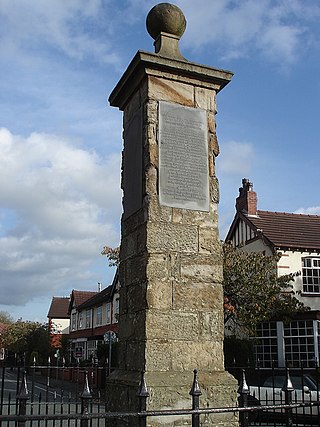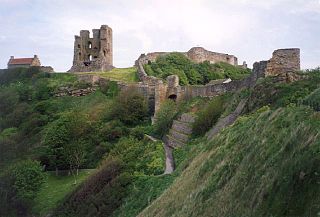Related Research Articles

George Monck, 1st Duke of Albemarle JP KG PC was an English soldier, who fought on both sides during the Wars of the Three Kingdoms. A prominent military figure under the Commonwealth, his support was crucial to the Restoration of Charles II in 1660, who rewarded him with the title Duke of Albemarle and other senior positions.

Colonel John Hewson, also spelt Hughson, was a shoemaker from London and religious Independent who fought for Parliament and the Commonwealth in the Wars of the Three Kingdoms, reaching the rank of colonel. Considered one of Oliver Cromwell's most reliable supporters within the New Model Army, his unit played a prominent part in Pride's Purge of December 1648. Hewson signed the death warrant for the Execution of Charles I in January 1649, for which he reportedly sourced the headsman, while soldiers from his regiment provided security.

Robert Lilburne (1613–1665) was an English Parliamentarian soldier, the older brother of John Lilburne, the well known Leveller. Unlike his brother, who severed his relationship with Oliver Cromwell, Robert Lilburne remained in the army. He is also classed as a regicide for having been a signatory to the death warrant of King Charles I in 1649. He was forty-seventh of the fifty nine Commissioners.
Francis Willoughby, 5th Baron Willoughby of Parham was an English peer of the House of Lords.
Colonel Sir Richard Ingoldsby was an English officer in the New Model Army during the English Civil War and a politician who sat in the House of Commons variously between 1647 and 1685. As a Commissioner (Judge) at the trial of King Charles I, he signed the king's death warrant but was one of the few regicides to be pardoned.

The Battle of Wigan Lane was fought on 25 August 1651 during the Third English Civil War, between a Royalist army led by the Earl of Derby and forces loyal to the Commonwealth of England under Colonel Robert Lilburne. The Royalists were defeated, losing nearly half their officers and men.

Sir Edward Rossiter was an English landowner, soldier and politician from Lincolnshire. He fought with the Parliamentarian army in the Wars of the Three Kingdoms and sat as an MP at various times between 1646 and 1660.

Sir William Lockhart of Lee (1621–1675), was a Scottish soldier and diplomat who fought for the Covenanters during the 1638 to 1651 Wars of the Three Kingdoms. Following Royalist defeat in the 1642 to 1647 First English Civil War, Lockhart took part in negotiations between Charles I and Scottish Engagers, who agreed to restore him to the English throne.

The Battle of Gainsborough was a battle in the First English Civil War, fought on 28 July 1643. The strategically important town of Gainsborough, Lincolnshire was a Royalist base used for harassing the Parliamentarians who were generally dominant in Lincolnshire, but was taken by Parliamentarians in July 1643. An attempt to recapture Gainsborough by Charles Cavendish and the Royalists was foiled in a battle in which Colonel Oliver Cromwell distinguished himself as a cavalry leader.
The Eastern Association of counties was an administrative organisation set up by Parliament in the early years of the First English Civil War. Its main function was to finance and support an army which became a mainstay of the Parliamentarian military effort until early 1645, when many of its units were incorporated into the New Model Army.

Sir Gilbert Pickering, 1st Baronet, 10 March 1611 to 17 October 1668, was a member of the landed gentry from Northamptonshire, and a religious Independent who supported Parliament in the Wars of the Three Kingdoms. An MP for Northamptonshire for most of the period from 1640 to 1660, during the 1649 to 1660 Interregnum he also served as Lord Chamberlain, sat on the English Council of State, and was appointed to Cromwell's Upper House in 1658.
The English Army existed while England was an independent state and was at war with other states, but it was not until the Interregnum and the New Model Army that England acquired a peacetime professional standing army. At the Restoration of the monarchy, Charles II kept a small standing army, formed from elements of the Royalist army in exile and elements of the New Model Army, from which the most senior regular regiments of today's British Army can trace their antecedence. Likewise, Royal Marines can trace their origins back to the formation of the English Army's "Duke of York and Albany's maritime regiment of Foot" at the grounds of the Honourable Artillery Company on 28 October 1664.

Sir Thomas Armstrong was an English army officer and Member of Parliament executed for treason.

James Berry, died 9 May 1691, was a Clerk from the West Midlands who served with the Parliamentarian army in the Wars of the Three Kingdoms. Characterised by a contemporary and friend as "one of Cromwell's favourites", during the 1655 to 1657 Rule of the Major-Generals, he was administrator for Herefordshire, Worcestershire, Shropshire and Wales.

Colonel John Pickering, baptised 3 December 1615, died 24 November 1645, was a member of the landed gentry from Northamptonshire who served with the Parliamentarian army in the First English Civil War. Like his elder brother Sir Gilbert Pickering, a close ally of Oliver Cromwell, he was a religious Independent, known for his devout faith and radical views. Appointed colonel of an infantry regiment in the New Model Army, he died of fever at Ottery St Mary on 24 November 1645.

The siege of Lincoln took place from 3 to 6 May 1644 during the First English Civil War, when the important town of Lincoln was besieged by Parliamentarian forces under the Earl of Manchester. On the first day, the Parliamentarians took the lower town. The Royalist defenders retreated into the stronger fortifications of the upper town, which encompassed and incorporated Lincoln Castle and Lincoln Cathedral. The siege ended four days later when the Parliamentarian soldiers stormed the castle, taking prisoner the Royalist governor, Sir Francis Fane, and what remained of his garrison.
Humphrey Walrond, was acting Governor and later Deputy-Governor of Barbados
Henry Jones of Asthall Manor, Oxfordshire was an officer in the New Model Army during the Interregnum. He transferred to the new small Royalist army of Charles II, serving as a Life Guard until he was dismissed after becoming a Roman Catholic. With King Charles's blessing he raised an English regiment of horse (cavalry) known as English Regiment of Light Horse in France for the French Army of Louis XIV. He was killed in action at the siege of Maastricht.

Sir William Stapleton, 1st Baronet was an Irish colonial administrator and planter who served as the governor of the Leeward Islands from 1671 to 1686, when he died in office. Born in Ireland to a family of Norman descent, William, as a Royalist during the Wars of the Three Kingdoms, followed Charles II into exile in France.

The Royalist Army in Exile was the army formed by those loyal to Charles II from 1656 to 1660 during his exile from the throne. They were a mixture of Royalist troops from his three Kingdoms including men from England and Scotland, with the bulk being Catholics from Ireland, many of whom had previously served in the Irish Confederate armies.
References
- Pape, Thomas (1938). Newcastle-under-Lyme in Tudor and early Stuart times, Manchester university press ([Manchester]).